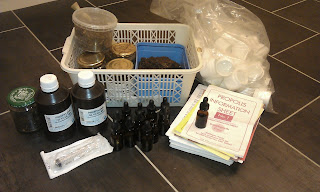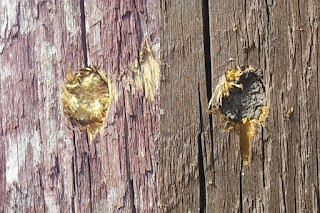Last weekend was the April 2013
Whitby Goth Weekend. But I had higher things on my mind as for bee keepers in this neck of the woods it's auction season, the time of year when beekeeper's swarm to various town and village halls, beer tokens at the ready to buy and sell a variety of beekeeping related gubbins ranging from the very useful such as actual live bees to the marginally less useful such as VHS video tapes (of bees) and pretty much everything in between. On Sunday the 28th it was the
Beverley Beekeepers Association 2013 Auction. This year I took a friend along, she'd never been to an auction before and when you get right down to it what girl doesn't secretly want to be spirited off to a local beekeeping auction?
As with last year I rolled up a few minutes after the bidding had started and too late to get a seat. Maybe next year I'll get there in time for a viewing, but I'll not put money on it. The first thing I noticed looking at the array of woodware with the occasional plastic or shiny steel item was the heather press which seemed to be at all the previous auctions I've attended was absent. Maybe it's found a home at last.
 |
| Auction stuff, don't think the extractor sold. |
This year I was after three things a strainer, a Snelgrove board and some food grade plastic buckets. There wasn't a strainer in the printed item list I'd brought with me
but the auction seems to get a lot of submissions on the day so I
figured one might appear. ..and not long after wandering in, a conical stainless steel tap strainer came up. Basically it's a device that hangs from the tap of your honey extractor or other container and honey coming out passes through leaving bits of wax and the odd bee leg or whatever behind. I picked it up for a fiver, they cost about £20 new so I was quite pleased with that. There's some glue from a paper label on it and a little what might be wax so I'll have to get some stainless steel cleaner or possibly a little caustic soda to it at some point. I can't just bung it in the dishwasher because it there's any wax on it will melt in the water and adhere to the machine.
 |
| Stainless Steel Conical Strainer, every home should have one. |
Thanks to being late we were standing to the side of the stage but I
spotted some spare seats in a hallway and brought a couple over seating
ourselves with an excellent view of the proceeding albeit a little close to the
Megamouth MP3 Pulse portable PA. Whilst the feedback wasn't quite at Jesus and Mary Chain levels it was enough to elicit the odd wince amongst the assembled. Moving the speaker a few feet to one side of the auctioneer fixed that.
My second purchase was two supers with castellated spacers. Purchased in the spirit of optimism. I'm hoping to need them for the huge honey harvest everyone is hoping for this year but nobody is really expecting. I'm not sure what they're made of but they're quite light, going by the weight and the colour I think they may be cedar.
 |
| Possibly Cedar supers, two for a dozen beer tokens. |
When I last fed the bees I later noticed there'd been some syrup leaking from the contact feeders I was using. Not surprising given the temperature changes we've been having recently. I don't hugely want my queens to die under a cascade of sugar syrup so when some rapid feeders came up I bid on some picking up a lot of four for twelve quid. They're a simple idea. It's a donut shaped bowl you pour syrup into, bees climb up the inside of the hole and access the syrup. Their access to the reservoir is limited by a plastic cup over the central column to minimise drowning incidents.
 |
| Rapid Feeders |
There was a break whilst the bees were auctioned outside, was a little windy out there so didn't stay out long to watch that myself, instead I took the opportunity to reconnoitre the items on the floor and note down what I was going to bid on. I pointed out a few things to my friend explaining what they were and picked up a solid wood floor to that'd been creosoted or something leaving me with a black thumb. Well there's probably a lesson for me there. I spotted two lots of buckets to bid on but no Snelgrove boards at all. There was a few interesting bits and bobs like a hive trolley for lugging hives around without putting out your back, a box of some rather worrying rubber objects that later turned out to be candle moulds, a handful of honey extractors, a rather swish honey refractometer.
 |
| Bariatric Kick Scooter! |
There was a lot of beehives in varying condition ranging from very used to
brand new. I suspect a couple had probably been made locally for sale
at the auction. Unfortunately I doubt my own woodworking skills would have
impressed anyone.
 |
| Rather fetching green and black national hive on a stand |
An old galvanised steel settling tank sat in one corner. You can't use these anymore as some bright spark realised that an acidic substance like say honey could leach zinc from the metal so now they have to be made from food grade plastic or stainless steel, but it was still an interesting looking lump of beekeeping history nonetheless. This one had strainer in the top part and a layer of plastic had been placed below it presumably to protect it.
 |
| An interesting lump of beekeeping history, and some plastic. |
There was an item looking a like a cross between a ski pole
and a walking stick. It was a honey creamer used to make set honey -the
opaque non runny type. I have a vague plan to try making some this year.
I didn't bid on that though, figure I'd wait and see if I get enough
honey to experiment with first.
 |
| Self righting walking stick |
After the bees were auctioned and I had a mug of tea (white no sugar if you're wondering) the auction returned inside. I was outbid on both lots of buckets but after the auction the chap who'd won a batch of seven for the rather good price of £6 offered them to me for the same which I took him up on. Now I have my all important buckets just need the bees to do their bit so I can fill them now :) I haven't photographed the buckets as I'm fairly certain most readers have a
rough idea what a bucket looks like. These ones are food grade white plastic, metal handles and white lids. I've mentioned food grade plastic a few times, the name suggests it's some sort of edible plastic but it isn't. Normal plastics can leach unpleasant things like
phthalates into food they're in contact with or in other cases may break down easily releasing carcinogens and other nastiness into your food and drink.
Food grade plastic is free of these things and of any surface contaminants too -which actually means food grade plastic coming into contact with something toxic is no longer food grade.
Back to the auction.. a stainless steel double strainer came up. This is two strainers with the coarser one fitting into and above the finer one. The whole thing goes into the top of a honey bucket supported by it's adjustable arms and honey poured in passes through first the 1.5mm mesh then the 0.5mm mesh. There was a new one going for twenty quid from the local supplier who was selling kit in an adjoining room so with that as a fallback and a guide price I stared bidding and got it for twelve of little gold coins, looks like it may be unused.
 |
| Take the strain |
Something I'd noticed in the auction listing was a lot labelled propolis kit. I don't get much propolis from my bees, there's ways to harvest it but I don't do it, not at the moment anyway It's touted to have useful health properties which are currently being investigated and is used in tinctures, salves and so on, curiously it's also used to make polishes for violins. Even more curiously propolis tincture tastes suspiciously reminiscent of
Jägermeister, the world's favourite Kräuterlikör. I spotted the lot near where I was seated. There was some containers of propolis, a bag of plastic tubs, some very old leaflets about the stuff, a litre of Propylene Glycol, some 30ml dropper bottles, an unused syringe and what appears to be a small wooden club. I think the little club might be for breaking up frozen propolis. Having read a little about propolis products I decided if there wasn't much interest I was going to bid on this curious lot. Turned out there was only myself and another person interested and I got it for under a tenner.
 |
| Propolis and chemical stuff. |
I reckon there's about 1.25 Kilo's of propolis in the various containers. Most of the bottles had a small amount of thick black propolis tincture in them. I have no idea of the composition of the tincture but it's very thick and I'd guess quite old. Other things I picked up were thirty 1lb jars for three quid and a batch of plastic frame runners. There was a few DEFRA leaflets around so I picked up some bedtime reading on
Tropilaelaps,
Varroa,
Foulbrood and the
Asian Hornet. Afterwards we adjourned to
Lempicka Cafe in Beverley for a very late lunch.
I didn't manage to get a Snelgrove board, but that's not a huge worry as I have one and can make a second myself if I really need to. It was quite a successful day. An email following up the event said about £4400 of business was done. The atmosphere at the auction was pleasant and the auctioneer kept things moving nicely -turns out he's the chap who keeps bees a few streets from me, small world.














+2013-05-07+15.44.07.jpg)

















